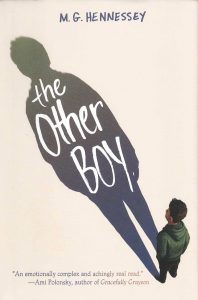 The Other Boy
The Other Boy
Written by M. G. Hennessey
Illustrated by Sfé R. Monster
HarperCollins, 2016, 234 pp.
ISBN-13: 978-0-0624-2766-3
This middle grade novel follows sixth-grader Shane Woods as he experiences the ups and downs of middle school: best friends, bullies, crushes, and parents. Shane is transgender, which challenges the status quo in Shane’s school, community, and our world. The book also challenges the status quo of books on transgender children and teens by illustrating the acceptance that Shane receives. While Shane’s conflicts may be heightened because he is transgender, this novel strives to show that whether boy or girl, transgender or cisgender, we all must stay true to ourselves.
Shane’s first-person narration begins with a conversation with his best friend Josh about their baseball team’s upcoming playoff game. At first, no one at Shane’s school in Los Angeles knows that he is transgender. He moved from San Francisco, where he first started his transition, and chose not to tell his new friends, teammates or classmates. Shane struggles with whether he should tell his best friend about his transition, how he should approach his crush, Madeline, and what to do when the school bully, Nico, spreads the rumor that Shane is really a girl.
By following his heart, Shane challenges the status quo. He wants to become the truest version of himself, and must face many challenges as a result. The first challenge arrives when Shane is in a doctor’s office with his mom and dad. Shane’s father does not want him to start taking testosterone. The confrontation is heated, “in a different way. Kind of an all-the-air-sucked-out-of-the-room way”(p. 45). While Shane and his mom have talked about the pros and cons of starting male hormones, Shane’s dad is only just learning. After hearing some of the consequences, Shane’s dad says, “You’re twelve. … You don’t know what you want” (p. 45). Shane feels sick as a result of this experience. He had hoped to walk away from the doctor’s appointment with a different outcome. Shane’s setback is detrimental to his growth. Hennessey’s ability to create empathy for Shane strengthens the emotional aspects of his dialogues and internal monologues. The reader feels Shane’s emotions, from his moments of misery and his belief that his current situation is the end of the world, to the moments where Shane feels triumphant due to his parents’ and friends’ support.
The grandiose feelings that twelve-year-olds experience may seem hyperbolic at times, but Hennessey uses this to show readers the enormity of the conflicts and challenges transgender youth face. Coupled with the low points are the high points. For example, Shane feels elated (and incredibly nervous) when he is invited over to his crush’s house for dinner one night. Later, after Shane’s baseball team plays the highly anticipated playoff game, the team celebrates Shane’s contribution. Shane also finds telling his friends and classmates about his transition is more satisfying than keeping it all to himself. These moments not only cause Shane great joy, but the reader feels his happiness and relief as well.
The Other Boy fits into the middle grade genre with its sixth-grade narrator. The novel also includes intermittent pages from a graphic novel that the main character works on, breaking up the pages of written text. Shane’s graphic novel is about a space explorer, Hogan Fillion, who fights aliens. When Shane explains his graphic novel and its inspiration, he says, “It was part Guardians of the Galaxy, part Star Trek, part Firefly (the best TV show, hands down)” (p. 13).
Monster’s black-and-white illustrations of the graphic novel use bold lines and solid fill. These pages from Shane’s graphic novel include comic book speech bubbles as well as the “oofs” and “ahhs” and explosions common to the genre. As Shane’s story progresses, so too does his graphic novel, and the reader meets new characters such as the invisible overlords of a faraway planet and the giant bubbles that prevent Hogan and Willoughby from escaping. After Shane’s scene at the doctor’s office, the reader sees a page of Hogan Fillion’s story, with Hogan pleading with the invisible overlords. “Please…” one speech bubble says. “We need your help. I’ll do anything!” says another (p. 49). This reflection of Shane’s own situation, where he hopes his dad will let him take the testosterone, nudges the reader once more by showing Hogan’s worried eyebrows and open-mouthed frown.
The Other Boy explores a very pertinent issue in today’s world and it is satisfyingly real. Like Hogan, twelve-year-old Shane stands tall with the help of his friends and family and inspires hope in the reader, as well as a sense of overcoming the odds and one’s personal reservations. Hennessey is an LGBTQ ally and identifies with she/her pronouns. The Other Boy is Hennessey’s first novel and with it she is advocating for more children’s and teen literature that represents all genders, the LGBTQ community, those with learning challenges and people of different religions and beliefs. Monster identifies themself as trans, queer in their Twitter bio and uses they/them pronouns. For further reading on middle-grade transgender novels, check out Gracefully Grayson by Ami Polonsky (2016), Lily and Dunkin by Donna Gephart (2016), George by Alex Gino (2015), and Wandering Son, Volume 1 by Takako Shimura, translated by Matt Thorn (2011).
Maya Patterson, University of Arizona, Tucson, AZ
WOW Review, Volume IX, Issue 2 by Worlds of Words is licensed under a Creative Commons Attribution-NonCommercial-ShareAlike 4.0 International License. Based on work at https://wowlit.org/on-line-publications/review/ix-2/
